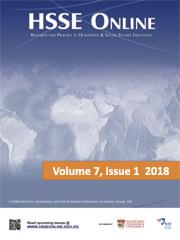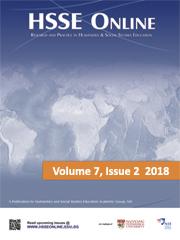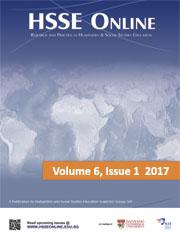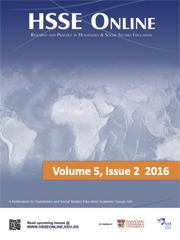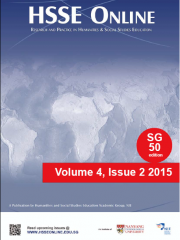Past Issues
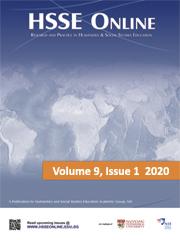
HSSE Online Editorial
The articles in this volume make a strong case for a re-invigorated Humanities and Social Studies education at all levels of schooling; an education that as Wang notes in the first article, helps educators “grow to become comfortable with the uncomfortable,” whether it be with controversial issues and difficult discussions, challenging inquiry methods or the move away from comfortable classroom routines to more inclusive, experimental and progressive pedagogies. All of the articles in this volume make a strong case for putting students firmly in charge of their learning, whether it be through constructive conflict talk, issues investigation, environmental action, empowering students to construct what it means to be a citizen, giving students greater voice and choice in their lessons, or using talk moves to enhance student participation and agency in Geography classes. Putting students at the center promises a shift away from teacher-dominated lessons and didactic instruction toward what makes learning worthwhile, engaging, relevant and meaningful for learners.
This move toward more experiential, active and challenging pedagogy involves addressing authentic social problems that connect to students’ experiences, teaching through meaningful classroom discussions and engaging students in complex thinking processes. Such learning supports the building of an inquiry culture, inquiry mindsets and the social practices that can support lifelong inquiry and learning. Each of the articles in this volume provide insights, examples and practical approaches that can move classroom practice more firmly in these directions.
The first article by Melvin Wang provides an approach to teaching controversial issues in primary schools by encouraging students to consider different points of view through the skillful use of open-ended questions and constructive conflict talk. This approach draws upon and respects students’ emotions, imagination and inventiveness to address conflicts they are likely to experience in their lives and as citizens. In doing so, students will be better prepared to understand and address conflict that is part of living in society with diverse others who will have different perspectives, values and emotional concerns, an important aspect of creating informed, concerned and participative citizens.
In the second article, Peidong Yang reports on a study that examined the challenges teachers face in teaching “Issues Investigation” as part of the issues- and inquiry-based Upper Secondary Social Studies syllabus released in Singapore in 2016, as well as how they “tamed” or managed these challenges in their instruction. The paper highlights how teachers and students must continually negotiate curriculum and instruction, given particular constraints and competing priorities encountered in educational settings.
The third article addresses the gap between students’ “knowing” and “doing” in Environmental Education in Singapore. The author, Yee Jie Ying, creates a framework to analyze components of Environmental Knowledge in the Lower Secondary Geography curriculum to show how the emphasis on knowledge may impede environmental action among students and the author calls for greater consideration of what sorts of knowledge might more effectively promote environmental stewardship among youth.
The fourth paper by Ysabel Ortiz is a moving autobiographical account of how powerful pedagogy and the influence of a teacher can inspire one to be a caring citizen with a keen sense of agency and commitment to one’s society and nation. The powerful idea of teaching the nation as a work in progress, an ongoing project continually formed and reformed by its citizens, invited the author to develop her own sense of agency as a citizen, empowered to contribute to the nation in her own way (as an educator). The transformative potential for both the individual and society is a testament to the ways an instructor can engage students in transformative pedagogies that deepen their sense of agency.
Lin Yunqing highlights the role of “talk moves” to engage students in the geographic literacies and thinking skills necessary to work with geographical data. In the fifth article of the issue, she draws on social constructivism to demonstrate how geographic knowledge construction is supported by talk moves that require students to voice and clarify their reasoning, listen closely to each other and engage with other students’ reasoning. The article outlines specific moves that can aid both teachers and students in classroom discussion to develop geographic understanding and skills.
The sixth article by Siti Dzhawieyah offers a teachers’ reflections on an action research project that gave her primary students greater voice and choice during monthly lessons on current affairs known as News Sharing. In her reflections, she highlights many of the tensions she experienced as a teacher in moving toward more student-centered discussions about complex issues.
Finally, Mark Baildon shares a commentary on inquiry-based learning (IBL) research in Singapore. In this article, he shares what Singapore-based research tells us about IBL and pedagogical practices in classrooms that have effectively supported IBL. This article was reprinted with special permission by NIE Perspectives. To access the site, click: https://nie.edu.sg/perspectives and log in with your NIE gmail which is in this format: john.smith@g.nie.edu.sg (log in with your NIE password). Alternatively, you can go to the NIE portal > Staff Services > NIE G Suite and click Perspectives. Following the commentary, is a curated list of related research by NIE faculty.
The articles in this issue of HSSE Online highlight the essence of a powerful humanities and social studies education in which students are taught to see themselves as both active learners and participatory social actors who can make a difference in their societies. On behalf of the authors of this issue, I invite you to dig into these articles, share them with your students and colleagues and continue to move the field of humanities and social studies education forward, toward new directions that are more meaningful, authentic and enriching for students and society.
Mark Baildon
Editor, HSSE Online
Exploring Controversial Issues in the Primary Social Studies Classroom
Wang Yao Chang Melvin (Rosyth School (Singapore) Keywords>Primary Social StudiesPrimary SchoolControversial IssuesClassroom IntroductionThe curriculum is an inextricable part of what prolific author and cultural critic Raymond Williams refers to as the “selective tradition” of schooling (Williams, 1977). What this means is that through the very selection of what is taught in school, only certain knowledge and […]
Wang Yao Chang Melvin (Rosyth School (Singapore)
Keywords>
Primary Social Studies
Primary School
Controversial Issues
Classroom
Introduction
The curriculum is an inextricable part of what prolific author and cultural critic Raymond Williams refers to as the “selective tradition” of schooling (Williams, 1977). What this means is that through the very selection of what is taught in school, only certain knowledge and perspectives will become official and legitimised, while others end up minimised or excluded (Luke, 1994; Versfeld, 2005). Against this backdrop, all educators invariably end up selecting for or against the various competing beliefs and interest groups situated within society.
Yet, the rise of new technologies in today’s global landscape has disrupted the status quo, providing many students unfettered access to alternative views across a spectrum of controversies that surround us – climate change, economic inequality, immigration, racism and how best to address them. It is becoming increasingly difficult for individuals, groups and especially schools to assert that they have sole custody and guardianship of the truth (Apple, 2009).
Given this context, there are pertinent questions that all Social Studies educators should consider. What role should schools play in addressing these powerful concerns of today’s youth? What type of controversial issues should teachers introduce in the classroom? Should teachers act as neutral facilitators or share their personal stance on these matters? Last but not least, what and whose knowledge should teachers teach?
Taming “Issue Investigation”: Singapore Secondary Social Studies Teachers’ Accounts of Challenges Encountered and Strategies for Coping
Peidong Yang (National Institute of Education (Singapore)) Keywords Social Studies Junior College Secondary School Social Studies social studies education Singapore teacher professional learning Introduction The upper-secondary Social Studies (SS) syllabus (Express/Normal-Academic) released in Singapore in 2016 introduced a component called “Issue Investigation” (II). Speaking to the target learners, the SS textbook defines and explains II as […]
Peidong Yang (National Institute of Education (Singapore))
Keywords
Social Studies
Junior College
Secondary School
Social Studies
social studies education
Singapore
teacher professional learning
Introduction
The upper-secondary Social Studies (SS) syllabus (Express/Normal-Academic) released in Singapore in 2016 introduced a component called “Issue Investigation” (II). Speaking to the target learners, the SS textbook defines and explains II as follows:
An Issue Investigation encourages you to identify a societal issue to develop a response to. A societal issue is one that is of concern to society and people have points of view about. An Issue Investigation allows you to analyse factors and perspectives that shape the development of societal issues. Through the course of the investigation, your group will also understand the impact the selected societal issue has on society and develop possible responses and recommendations to address the issue. (Ministry of Education, 2016a, p. 367)
In terms of carrying out II, the textbook prescribes a four-stage cycle: (1) sparking curiosity; (2) gathering data; (3) exercising reasoning; (4) reflective thinking. It thus seems that II is positioned as an inquiry-driven learning activity that helps students gain analytical insights into pertinent societal issues, which in turn serve the broader objective of Social Studies to develop learners into “informed, concerned and participative citizens” (Ministry of Education, 2016a, p. iii).
Environmental Education in Singapore: An Analysis of Environmental Knowledge in the Lower Secondary Geography Curriculum
Yee Jie Ying (National Institute of Education (Singapore)) Keywords Geography Junior College Secondary School Environmental education Introduction Curricula Goals of Environmental Education Environmental education (EE) was first developed at a time when environmental degradation became widely prominent (UNESCO, 1976). EE becomes even more relevant today as we are ever pressured by pressing environmental issues such as […]
Yee Jie Ying (National Institute of Education (Singapore))
Keywords
Geography
Junior College
Secondary School
Environmental education
Introduction
Curricula Goals of Environmental Education
Environmental education (EE) was first developed at a time when environmental degradation became widely prominent (UNESCO, 1976). EE becomes even more relevant today as we are ever pressured by pressing environmental issues such as those arising from pollution, waste management, and climate change, both locally and globally. The 1975 Belgrade Charter was the first milestone of EE, providing an international framework for EE to rapidly proliferate in many cities. Essentially, EE aims to:
“develop a world population that is aware of, and concerned about, the environment and its associated problems, and which has the knowledge, skills, attitudes, motivations and commitment to work individually and collectively towards solutions of current problems and the prevention of new ones” (UNESCO, 1976, p. 2).
Backtracking towards a Transformative Rizal Curriculum
Ysabel Julia M. Ortiz (National Institute of Education (Singapore) Keywords Junior College Secondary School Jose Rizal curriculum as political text critical pedagogy curriculum as autobiographical/biographical text Introduction Since 1956, Republic Act 1425, otherwise known as the Rizal Law, has mandated the teaching of the life and works of Philippine national hero, Jose Rizal, in all public […]
Ysabel Julia M. Ortiz (National Institute of Education (Singapore)
Keywords
Junior College
Secondary School
Jose Rizal
curriculum as political text
critical pedagogy
curriculum as autobiographical/biographical text
Introduction
Since 1956, Republic Act 1425, otherwise known as the Rizal Law, has mandated the teaching of the life and works of Philippine national hero, Jose Rizal, in all public and private schools, colleges and universities. Why decree Rizal’s ideas of nationhood and citizenship in the Philippine social studies curriculum? Dumol & Camposano’s (2018) textbook The Nation as Project: A New Reading of Jose Rizal’s Life and Works begins with a pithy statement that perhaps expresses the rationale best: “When Jose Rizal was born in 1861, there was no Filipino nation to speak of . . . When Jose Rizal died in 1896, there was still no nation to speak of, but [through his writings, political campaigns, and the reason for his execution] there was a nation to dream of” (p. 3). To examine Rizal’s life and works, therefore, is “to discover who we are and where we might go as a nation” (Dumol & Camposano, 2018, p. 3).
But the Rizal Law’s lofty directive that his works be an “inspiring source of patriotism” to the youth today is thwarted by curricula widely comprised of a reverential reading of Rizal’s life and works (Dumol & Camposano, 2018). As such, his ideas are left decontextualized and are resultantly barren. Without explanation for how Rizal’s ideas emerged amidst the social conditions of his time, a central truth—that the individual’s thoughts and actions bear weight on the ongoing project of the nation—remains veiled from students.
Where Literacy Meets Geography: Using Talk Moves to Engage Students in Geographical Data
Lin Yunqing (National Institute of Education (Singapore) Keywords Geography Junior College Secondary School pedagogy Student Learning Introduction The theoretical foundation of this study is social constructivism which believes that knowledge is produced and constructed in a social setting. This socialcultural perspective emphasises that literacy is shaped by social practices (Moje, 1996) and serves the purpose of […]
Lin Yunqing (National Institute of Education (Singapore)
Keywords
Geography
Junior College
Secondary School
pedagogy
Student Learning
Introduction
The theoretical foundation of this study is social constructivism which believes that knowledge is produced and constructed in a social setting. This socialcultural perspective emphasises that literacy is shaped by social practices (Moje, 1996) and serves the purpose of knowledge construction in a discipline (Moje, 2008). It builds students’ understanding of the acceptable form of “socialisation into how members of a community talk, write, and participate in knowledge construction” (Quinn, Lee, & Valdés, 2012, p. 49). Like other disciplines, the geography epistemic community has its own ways of seeing and understanding the world (Roberts, 2013) which are different from “everyday thinking” (Lambert, 2017, p. 20).
The demands of each discipline determine the literacy skills that students need to address the domain-specific problems of the discipline in question (Brozo, Moorman, Meyer, & Stewart, 2013). From a geo-literacy perspective, the implementation of a literacy approach in geography should then serve the needs of geographical learning by taking into account the characteristics of knowledge formation and interaction in that discipline (Burke & Welsch, 2018). Therefore, the social construction of geographical knowledge requires students to be “geographically literate” in order to effectively comprehend geographical information, engage in reasoning, communicate their ideas and make informed decisions (Dolan, 2019). Geography teachers draw upon a rich range of data representations to bring the geographical concepts to life in their teaching (Lambert & Balderstone, 2010) and guide students in studying physical and socio-cultural phenomena, and interactions between people and their environments. These data representations include graphs, maps, photos, sketches, table of figures and texts (CPDD, 2013). Therefore, to help students become “geographically literate” entails equipping them with skills to make sense of and critique geographical data presented in multimodal formats (Roberts, 2014). Such data analytical skills are also required in Singapore’s Geography curriculum (CPDD, 2013):
- Extract relevant information from geographical data;
- Interpret and recognize patterns in geographical relationships data;
- Analyse, and evaluate and synthesize geographical data to make informed and sound decisions.
Centering the Periphery: Giving Students’ Voice and Choice
Siti Dzhawieyah (Elias Park Primary School (Singapore) Keywords Primary Primary School education social studies education In April 2019, I carried out an action research study with a class of High Ability Primary 6 students to understand how to better engage students in a Social Studies class through discussion of controversial issues. Based upon my observations, these […]
Siti Dzhawieyah (Elias Park Primary School (Singapore)
Keywords
Primary
Primary School
education
social studies education
In April 2019, I carried out an action research study with a class of High Ability Primary 6 students to understand how to better engage students in a Social Studies class through discussion of controversial issues. Based upon my observations, these students demonstrated behaviors that showed they were disengaged during the monthly lesson on current affairs known as News Sharing. During News Sharing class, students were typically given an adapted news article chosen by me with a set of questions that tested mainly their comprehension of the article, the relevance of the article to National Education (NE) messages and how they might contribute to society based on the issue featured in the article. I felt that the formulaic nature of the lesson defeated the aim of News Sharing which was initially introduced with the purpose of improving students’ general knowledge about the world and Singapore. The lesson eventually resulted in an English language comprehension class where discussion was minimal and almost perfunctory.
I was quite dissatisfied with the state of affairs as it ran counter to my vision of what a Social Studies class should be and my transformative role as a Social Studies teacher. I felt as if I was oppressing my students, viewing them simply as empty receptacles waiting to be filled up by content. It was an untenable situation. Upon further probing, these students shared that they would like for the lesson to be changed, especially on the topics that were discussed as well as the approach. They expressed the desire to discuss topics that were of interest to them instead of those chosen by the teacher. Among the topics that they suggested were meritocracy, issues on foreign talents, gender inequalities as well as academic demands. I took their suggestions to heart and began to search for a better approach to discuss these topics. I also decided to frame the issues in a way where they could be controversial in nature and thus invite livelier discussion. Furthermore, this was an area that I felt merited further investigation since findings from this action research would have implications for other Social Studies teachers who might be interested to find out how they could introduce controversial issues as a way to engage their primary school students.
Exploring Controversial Issues in the Primary Social Studies Classroom
Wang Yao Chang Melvin (Rosyth School (Singapore) Keywords>Primary Social StudiesPrimary SchoolControversial IssuesClassroom IntroductionThe curriculum is an inextricable part of what prolific author and cultural critic Raymond
Taming “Issue Investigation”: Singapore Secondary Social Studies Teachers’ Accounts of Challenges Encountered and Strategies for Coping
Peidong Yang (National Institute of Education (Singapore)) Keywords Social Studies Junior College Secondary School Social Studies social studies education Singapore teacher professional learning Introduction The upper-secondary
Environmental Education in Singapore: An Analysis of Environmental Knowledge in the Lower Secondary Geography Curriculum
Yee Jie Ying (National Institute of Education (Singapore)) Keywords Geography Junior College Secondary School Environmental education Introduction Curricula Goals of Environmental Education Environmental education (EE) was
Backtracking towards a Transformative Rizal Curriculum
Ysabel Julia M. Ortiz (National Institute of Education (Singapore) Keywords Junior College Secondary School Jose Rizal curriculum as political text critical pedagogy curriculum as autobiographical/biographical text
Where Literacy Meets Geography: Using Talk Moves to Engage Students in Geographical Data
Lin Yunqing (National Institute of Education (Singapore) Keywords Geography Junior College Secondary School pedagogy Student Learning Introduction The theoretical foundation of this study is social constructivism
Centering the Periphery: Giving Students’ Voice and Choice
Siti Dzhawieyah (Elias Park Primary School (Singapore) Keywords Primary Primary School education social studies education In April 2019, I carried out an action research study with

